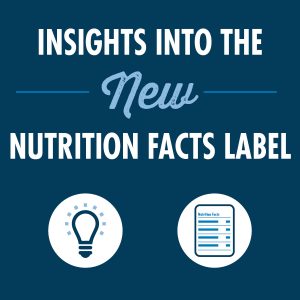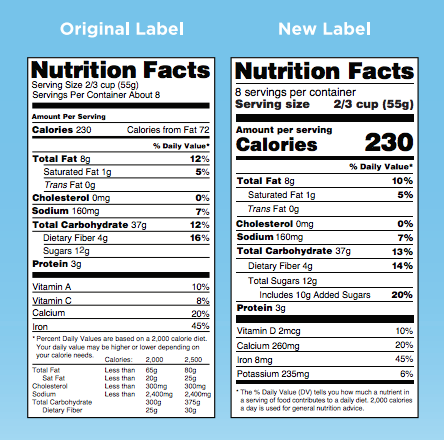
In May 2016 the FDA unveiled new Nutrition Facts label requirements for packaged foods. According to the agency, the new label is aimed to “reflect new scientific information, including the link between diet and chronic diseases such as obesity and heart disease.” With easier-to-read important nutrition information, consumers will be able to make better-informed decisions. Because the new label requirements have implementation deadlines in 2019 and 2020 (depending on the size of your business) many companies are already in full swing to update their full line of food products. Read on to learn more about what’s involved with the changes and what you can do to make sure that your brand is ready for them.
The Changes
While the overall design of the revised Nutrition Facts label looks very similar to the previous format, there are major updates at the top of the panel. You’ll immediately notice the larger sized font for the calorie count and serving sizes. This allows consumers to quickly find the most relevant information they need to make a decision.
The new label will also feature updated serving sizes for standard quantities based on today’s consumption habits–as opposed to 20-30 years ago. A soda, for example, previously had a serving size of just 8 oz, despite the more common size of a 12 oz can. While 12 oz will be the new serving size, products that fall between one and two servings (e.g. a 20 oz soda bottle), will be required to be labeled as one serving because consumers typically drink a whole bottle in one sitting.
For other products that are larger than two servings, but could still be consumed in one sitting, a “dual column” will be placed on the label to indicate the per serving and per package nutrition facts. You can download the FDA’s updated RACC (Reference Amounts Customarily Consumed) for more information on your specific product.
In addition to changes for the calorie count and serving size, adjustments are also being made to the vitamin and nutrient sections of the label. Calories from fat have been removed, while added sugars like maple syrup and bagged sugar are now required to be listed on the panel. Vitamins that were once required, such as Vitamins A and C, are no longer required to be listed since deficiencies of these vitamins are rare. Vitamin D and Potassium are now required to be listed because many Americans do not get the recommended amount. Finally, changes are being made to the Daily Value portion of the panel to make it easier for consumers to understand what each percentage value means.
Moving Forward
The FDA has set two deadlines for companies to meet the new Nutrition Facts label requirements. Businesses with $10 million or more in food sales a year are required to make their necessary label changes by the end of 2019, while those that do not meet this threshold will have until December 31, 2020.
Although we are months away from the first deadline it’s critical that brands start taking the necessary steps to ensure a successful transition. In fact, many brands have already started rolling out these new changes to ensure compliance by the deadline. Anheuser-Busch has taken a proactive approach to the labeling, though their category is not required to make the updates. As an early adopter, the beer giant is marketing the label addition as a show of transparency, which resonates with the consumers drive for information about the food and drinks they consume.




